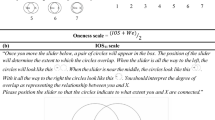Abstract
The purpose of this article is to discuss an integration of Minuchin's boundary continuum and Bowen's differentiation scale. Minuchin's boundary continuum provides a framework for understanding proximity and distance within relationships. It graphically depicts health in relationships as being a dynamic middle ground between the extremes of enmeshment and disengagement. Bowen's differentiation scale illustrates differences in emotional health, such as the ability to distinguish between thoughts and feelings, associated with varying levels of differentiation. A curvilinear integration of Minuchin's continuum and Bowen's scale retains the advantages of each and also expands their understanding.
Similar content being viewed by others
REFERENCES
Bowen, M. (1976). Theory in the practice of psychotherapy. In P. Guerin (Ed.), Family therapy: Theory and practice (pp. 42–90). New York: Gardner Press.
Bowen, M. (1978). Family therapy in clinical practice. New York: Jason Aronson.
Bray, J. H., & Harvey, D. M. (1992). Intimacy and individuation in young adults: Development of the young adult version of the personal authority in the family system questionnaire. Journal of Family Psychology, 6, 152–163.
Bray, J. H., Williamson, D. S., & Malone, P. E. (1986). An evaluation of an intergenerational consultation process to increase personal authority in the family system. Family Process, 25, 423–435.
Carter, B., & McGoldrick, M. (Eds.). (1989). The changing family life cycle: A framework for family therapy (2nd ed.). Boston: Allyn and Bacon.
Feldman, L. B. (1982). Dysfunctional marital conflict: An integrative interpersonal-intrapsychic model. Journal of Marriage and Family Therapy, 8, 417–428.
Framo, J. L. (1981). The integration of marital therapy with sessions with family of origin. In A. S. Gurman & D. P. Kniskern (Eds.), Handbook of family therapy (pp. 133–158). New York: Brunner/Mazel.
Horwitz, L. (1983). Projective identification in dyads and groups. International Journal of Group Psychotherapy, 33, 254–279.
Kerr, M. E., & Bowen, M. (1988). Family evaluation: An approach based on Bowen theory. New York: Norton.
Lerner, H. G. (1985). The dance of anger. New York: Harper & Row Publishers.
Minuchin, S. (1974). Families and family therapy. Cambridge, MA: Harvard University Press.
Minuchin, S., & Fishman, H. C. (1981). Family therapy techniques. Cambridge, MA: Harvard University Press.
Scarf, M. (1987). Intimate partners: Patterns in love and marriage. New York: Ballantine Books.
Waldo, M., & Harman, M. J. (1993). Relationship enhancement therapy with borderline personality. The Family Journal, 1, 25–30.
Williamson, D. S., & Bray, J. H. (1988). Family development and change across the generations: An intergenerational perspective. In C. J. Falicov (Ed.), Family transitions: Continuity and change over the life cycle (pp. 357–384). New York: Guilford Press.
Author information
Authors and Affiliations
Rights and permissions
About this article
Cite this article
Johnson, P., Waldo, M. Integrating Minuchin's Boundary Continuum And Bowen's Differentiation Scale: A Curvilinear Representation. Contemporary Family Therapy 20, 403–413 (1998). https://doi.org/10.1023/A:1022429332033
Issue Date:
DOI: https://doi.org/10.1023/A:1022429332033




